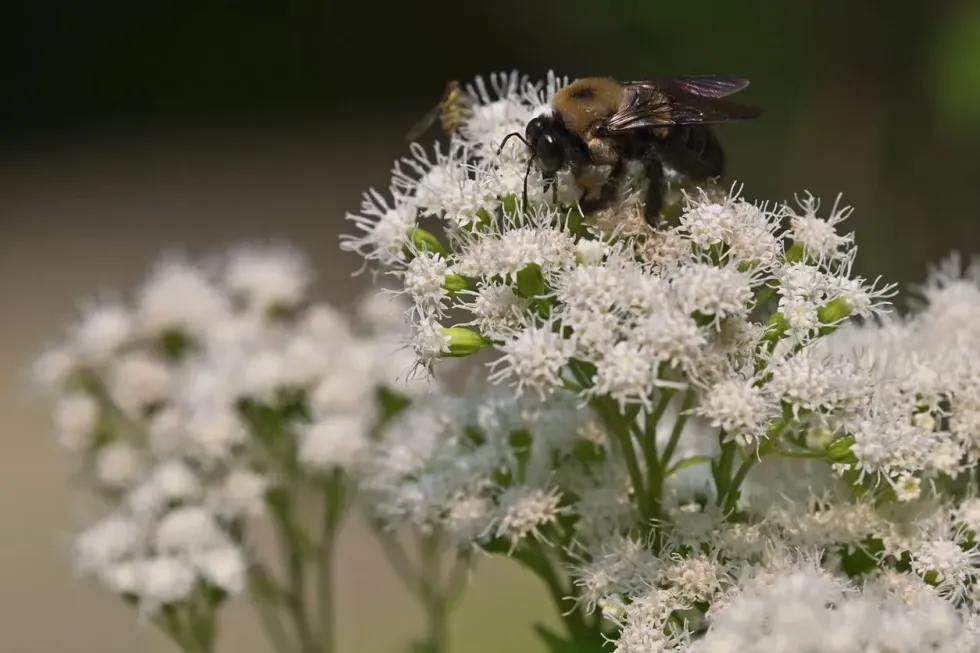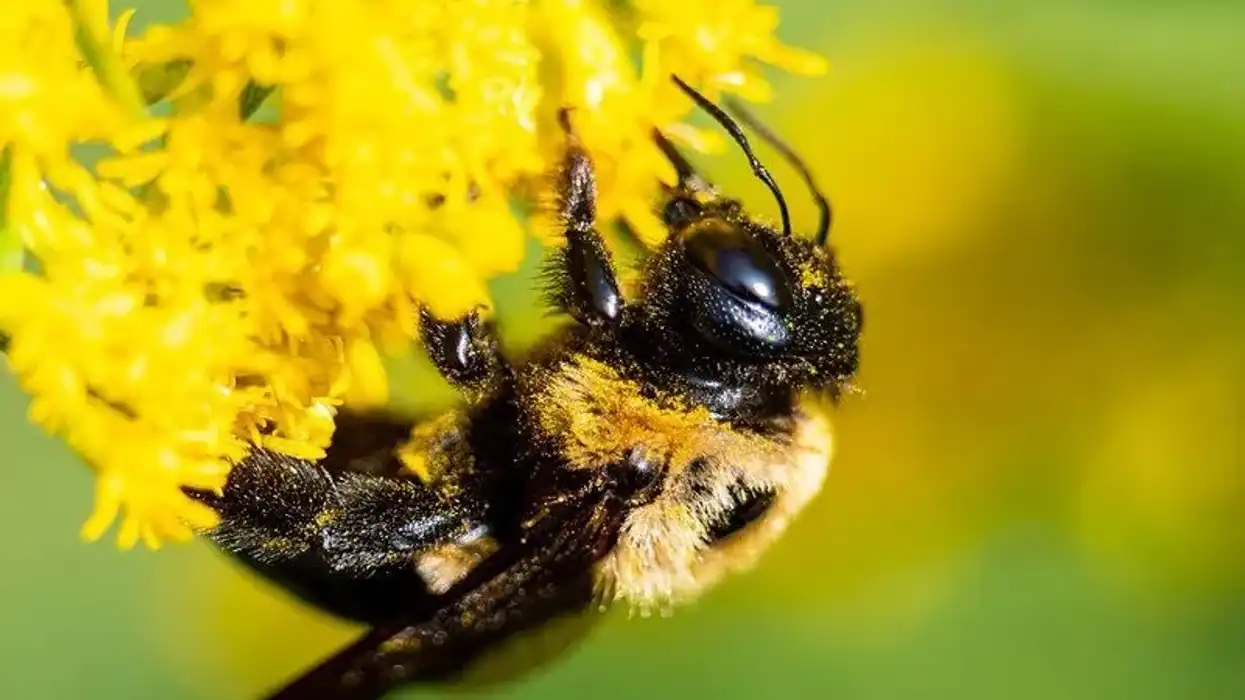Carpenter bees are part of the genus Xylocopa and belong to the Xylocopinae subfamily. There are 500 bees in the genus, divided into 31 subgenera.
The word 'carpenter bee' comes from the fact that almost all species bore holes in wood or hard plants, such as dead wood or bamboo, to lay eggs. They are famous for the fact that they bore a tunnel and brood chambers into the wood.
An entrance hole in bamboo or timber is a telltale sign of a carpenter bee nest.
These bees dig breeding tunnels in suitable soil. These tunnels have an entrance hole that penetrates the wood around the wood grain and then they bend at a right angle to meet the wood grain for 6-8 in (15-20 cm). After tunneling is complete, the bee will build individual cells or holes along the tunnels' length.
Many species of carpenter bees in this massive genus are difficult to distinguish, but most of them are all black or mostly black with some yellow or white coloring. A carpenter bee's appearance is strikingly similar to that of a bumblebee, but there are few differences in the appearance of a bumblebee and a carpenter bee.
Some only vary in minor morphological specifics, such as the male genitalia. Male carpenter bees in some species are also distinguished from females by their greenish-yellow fur.
However, females have a stinger, unlike males. Carpenter bees are the largest bees native to the USA, along with bumblebees.
If you liked reading this, you must also read our articles on house crickets and the Asian lady beetle.
Carpenter Bee Interesting Facts
What type of animal is a carpenter bee?
All bees (carpenter bees included) are insects.
What class of animal does a carpenter bee belong to?
Carpenter bees belong to the Insecta class.
How many carpenter bees are there in the world?
The exact number of carpenter bees worldwide is not known, but they are found pretty much in abundance across the world, especially in the US.
Where does a carpenter bee live?
Carpenter bees are solitary and unsocial insects, unlike honeybees or bumblebees who live in groups. Instead, they build individual nests by making holes and brood chambers in trees or in the supports, eaves, or sides of houses.
What is a carpenter bee's habitat?
Nesting sites for eastern carpenter bees include sandy, coniferous forests, wood logs, and other dead trees. They nest by digging long tunnels up to 18.5 in (47 cm) long into the wood. Cypress, fir, and juniper trees are popular places to find carpenter bee nests.
Who do carpenter bees live with?
Carpenter bees are not at all social. Carpenter bees are solitary bees. They prefer to live individually instead of in groups, unlike other species of bees.
How long does a carpenter bee live?
Carpenter bees have a long lifespan of up to three years. Usually, newly hatched daughters share a nest with their mothers.
How do they reproduce?
Carpenter bees tend to have two distinct mating systems. Males of species with wide eyes have a mating mechanism in which they patrol for females or hover and wait for passing females, who they then follow.
Males in the other mating scheme have tiny heads. A huge, hypertrophied glandular reservoir in the mesosoma releases pheromones into the airstream behind these male bees as they're flying or hovering. The pheromone alerts the female about the presence of the male.
Adults spend the winter on their own, often in brood tunnels that have already been established. Many that make it through the winter emerge and mate in the spring.
Female carpenter bees that have been fertilized bore into wood, excavating a tunnel to lay eggs. Around five to six cells are built within the tunnel to house the individual eggs.
The bee fills each cell with pollen (gathered from spring-flowering plants) and a single egg, then seals each chamber of the wood hole with regurgitated wood pulp, working backward once the egg is laid. The pollen serves as a food supply for the developing larvae during the hatching and maturation process, which takes several weeks inside the hole.
The larvae become adults and emerge in the summer. They then forage on flowers and bore holes into the wood before hibernating in the fall.
What is their conservation status?
The conservation status of carpenter bees is listed as Least Concern. They have a stable population.
Carpenter Bee Fun Facts
What do carpenter bees look like?
Carpenter bees (Xylocopa violacea) are largely black and yellow in appearance and they measure about 0.5-1 in (1.2-2.5 cm) in length. They look like bumblebees, but their abdomen is black and glossy, instead of the yellow hairs that bumblebees have.
Carpenter bees have a bare and shiny abdomen, whereas the head, thorax, and abdomen of bumblebees are all fluffy. Bumblebees do not have a shiny abdomen, but a carpenter bee does.
A thin yellow band runs down the thorax, and the belly is yellow and purple. Some carpenter bee species have yellow thoraxes, while others have a white, purple, brown, or blue thorax.
How cute are they?
Carpenter bees are not cute. They are technically pests that can destroy chunks of wood in the blink of an eye, leading to a lot of waste of wooden resources.
How do they communicate?
Carpenter bees communicate through vibrations, sounds, pheromones, and even by dancing around.
How big is a carpenter bee?
A carpenter bee is just about 0.5-1 in (1.2-2.5 cm) long.
How fast can a carpenter bee fly?
Carpenter bees can be seen flying at an approximate speed of around 20 mph (32 kph).
How much does a carpenter bee weigh?
The weight of carpenter bees is not known because they are such tiny insects.
What are the male and female names of the species?
There is no separate name for male and female carpenter bees. They are simply referred to as male and female carpenter bees. Female carpenter bees can sting, whereas males cannot.
What would you call a baby carpenter bee?
There is no specific name for a baby carpenter bee. They are simply called baby carpenter bees.
What do they eat?
Carpenter bees buzz like saws when building holes in wood to use as nests, and they don't actually eat wood, they simply make holes in it. Instead, they feed on nectar from flowering plants, with females gathering pollen for their young as well as themselves.
A pollen ball and regurgitated nectar are placed in each brood cell by female bees to provide food for their larvae. The larvae then emerge as adult bees in late summer.
Are they poisonous?
No, although female carpenter bees can sting humans, they are not poisonous. They do not bite humans.
Would they make a good pet?
Carpenter bees are creatures who live in the wild. Their nesting habits are more suited to the woods, and hence they cannot be kept as pets.
They make their nest in dead wood or bamboo. This particular pest does not consume wood, but it does dig tunnels in wood to use as nests.
They are commonly found in the eaves of houses, as well as decks and porches. Every year, many homeowners see these bees in their eaves, but they are not pets. Carpenter bee adults spend the winter in their nests and reappear in the spring.
Once they emerge after spring, they are often found tunneling wooden surfaces. They cause great structural damage to the wood when they do this, hence why they are classified as pests.
Proper pest control can help people get rid of infestations of carpenter bees to save the wooden structures in their homes. However, it is important to remember that an infestation of these bees shouldn't be killed as they play an important role in nature by feeding on the nectar of flowers.
Did you know...
Carpenter bees live in every continent except Antarctica. They are inactive during the night and rest in their hives.
Carpenter bees and bumblebees are different in many ways, such as in their different nesting habits. Bumblebees make their nests near the ground, in areas such as compost heaps, wood or leaf dumps, or abandoned rodent holes, whereas carpenter bees make their nests by making holes in wood designed carefully into chambers for their eggs.
Moreover, bumblebees are very social, unlike carpenter bees, and they sting to protect their nests. Carpenter bees do not sting like a bumblebee.
Female carpenter bees have a stinger and can sting, but they only do so when provoked. Male carpenter bees are unable to sting, so, they are generally not harmful.
What smell do carpenter bees hate?
Carpenter bees despise the scent of citrus oil. Therefore, citrus oil is considered one of the best repellents for carpenter bees and it is effectively used as a pest control method to prevent an infestation of carpenter bees from laying their eggs in and destroying wood.
Are carpenter bees good for anything?
Large carpenter bees from the genus Xylocopa are wood-nesting generalist pollinators with differing degrees of sociality that have a broad geographic range. Carpenter bees have successfully pollinated passion flowers, blueberries, greenhouse strawberries, and greenhouse melons.
However, the amount of structural damage that an infestation of adult carpenter bees can cause in their tunnel in wooden materials arguably outweighs their advantages.
Here at Kidadl, we have carefully created lots of interesting family-friendly animal facts for everyone to discover! Learn more about some other arthropods from our hister beetle facts and striped cucumber beetle facts pages.
You can even occupy yourself at home by coloring in one of our free printable carpenter bee on it coloring pages.










